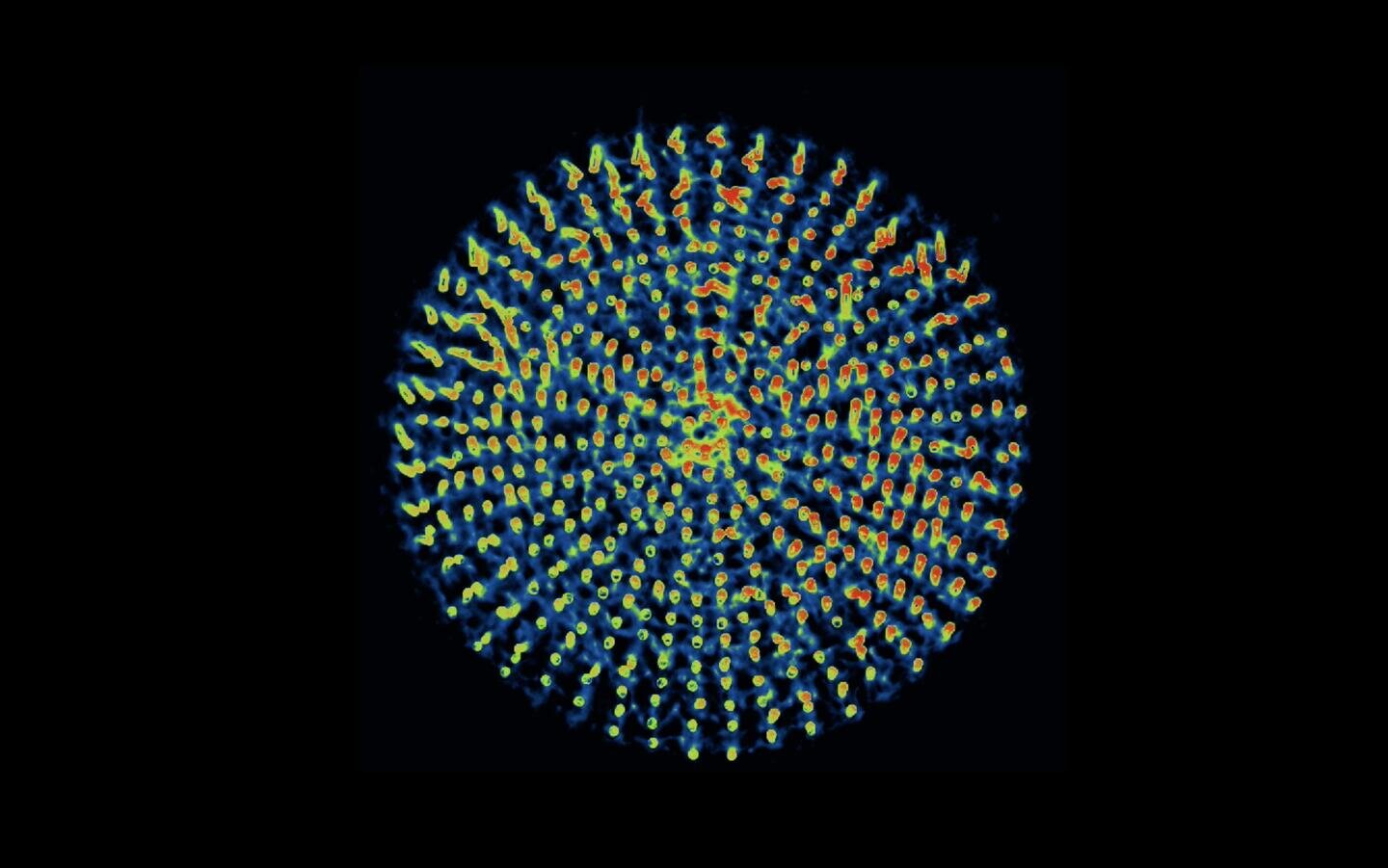博文
自我驱动的,无限可编程的人工纤毛
 精选
精选
||
自我驱动的,无限可编程的人工纤毛
诸平

Credit: Harvard University
据美国哈佛大学(Harvard University)2022年5月6日提供的消息,自我驱动的,无限可编程的人工纤毛(Self-propelled, endlessly programmable artificial cilia)。
多年来,科学家们一直试图为微型机器人系统设计微型人工纤毛,使其能够执行复杂的运动,包括弯曲(bending)、扭转(twisting)和反转(reversing)。建造这些比人的头发还小的微结构通常需要多步制造过程和不同的刺激来创造复杂的运动,这限制了它们的广泛应用。
现在,来自哈佛大学约翰·保尔森工程与应用科学学院(Harvard John A. Paulson School of Engineering and Applied Sciences简称SEAS)的研究人员,已经开发出一种单一材料、单一刺激的微结构,它甚至可以超越活体纤毛。这些可编程的微米级结构可以用于一系列应用,包括软机器人、生物兼容的医疗设备,甚至动态信息加密。相关研究结果于2022年5月5日已经在《自然》(Nature)杂志网站发表——Shucong Li, Michael M. Lerch, James T. Waters, Bolei Deng, Reese S. Martens, Yuxing Yao, Do Yoon Kim, Katia Bertoldi, Alison Grinthal, Anna C. Balazs, Joanna Aizenberg. Self-regulated non-reciprocal motions in single-material microstructures. Nature, 2022, 605: 76-83. DOI: 10.1038/s41586-022-04561-z. Published: 04 May 2022. https://www.nature.com/articles/s41586-022-04561-z
参与此项研究的除了来自美国哈佛大学的研究人员之外,还有来自美国匹兹堡大学(University of Pittsburgh, PA, USA)以及荷兰格罗宁根大学(University of Groningen, Netherlands)的研究人员。
哈佛大学约翰保尔森工程与应用科学学院(John A. Paulson School of Engineering and Applied Sciences, Harvard University)材料科学Amy Smith Berylson教授、哈佛大学化学与化学生物学系(Department of Chemistry and Chemical Biology)化学与化学生物学教授、上述论文的通讯作者乔安娜·艾森贝格(Joanna Aizenberg)说:“自适应自我调节材料的创新代表了一个非常活跃的领域,这是一个由跨学科的科学家和工程师团队解决的问题。该领域取得的进展可能会对我们设计各种应用材料和设备的方式产生重大影响,包括机器人、医学和信息技术。”
之前的研究主要依赖于复杂的多组分材料来实现可重构结构元件的可编程运动,与此不同,乔安娜·艾森贝格和她的团队设计了一种由单一材料制成的微结构支柱——一种光响应液晶弹性体。由于液晶弹性体的基本构造块是对齐的,当光线照射到微观结构时,这些构造块会重新对齐,结构也会改变形状。
当这种形状发生变化(shape change)会发生两件事。首先,光线照射的地方变得透明,允许光线进一步渗透到材料中,造成额外的变形。其次,随着材料的变形和形状的移动,支柱上的一个新点暴露在光线下,导致该区域也改变了形状。
这个反馈循环(feedback loop)驱使微结构进入一个类似冲程的运动循环。
“这种内部和外部反馈循环为我们提供了一种自我调节的材料。一旦你打开,它就会自己工作,”哈佛大学化学与化学生物系研究生、该论文的共同第一作者之一李树聪(Shucong Li音译)说。
当灯熄灭时,这种材料迅速恢复原来的形状。
这种材料的特殊扭曲和运动随其形状而变化,使这些简单的结构无休止地可重新配置和调整。通过模型和实验,研究人员展示了圆形、方形、L形、T形和棕榈树形结构的运动,并列出了材料可以调整的所有其他方式。
“我们表明,我们可以通过定制一系列参数,包括照明角度(illumination angle)、光强度(light intensity)、分子排列(molecular alignment)、微结构几何(microstructure geometry)、温度、照射间隔和持续时间,来编程这种动态舞蹈。”乔安娜·艾森伯格实验室的博士后、该论文的另一位共同第一作者迈克尔·勒希(Michael M. Lerch)说。
为了增加另一层的复杂性和功能性,研究团队还演示了这些柱状物作为数组的一部分是如何相互作用的。
李树聪说:“当这些支柱聚集在一起时,它们以非常复杂的方式相互作用,因为每个变形的支柱都在其周围投下阴影,在变形过程中,阴影会发生变化。对这些阴影介导的自我暴露如何变化和相互动态交互进行编程,可能对动态信息加密等应用很有用。”
乔安娜·艾森伯格说:“个人运动和集体运动的巨大设计空间可能会改变软机器人、微型步行者、传感器和稳健的信息加密系统。”
这项工作主要由美国陆军研究办公室支持(US Army Research Office, under grant number W911NF-17-1-0351),还有美国国家科学基金会(National Science Foundation简称NSF)通过哈佛大学(Harvard University)材料研究科学与工程中心(Materials Research Science and Engineering Center简称MRSEC)资助(under award DMR-2011754)以及荷兰科学研究组织(Nederlandse Organisatie voor Wetenschappelijk Onderzoek简称NWO, Rubicon Fellowship 019.182EN.027)的支持。
上述介绍,仅供参考。欲了解更多信息,敬请注意浏览原文或者相关报道。
将圆形转化为方形:研究人员在微观尺度上重新配置材料拓扑结构(Transforming circles into squares: Researchers reconfigure material topology on the microscale)
Living cilia stir, sweep and steer via swirling strokes of complex bending and twisting, paired with distinct reverse arcs1,2. Efforts to mimic such dynamics synthetically rely on multimaterial designs but face limits to programming arbitrary motions or diverse behaviours in one structure3,4,5,6,7,8. Here we show how diverse, complex, non-reciprocal, stroke-like trajectories emerge in a single-material system through self-regulation. When a micropost composed of photoresponsive liquid crystal elastomer with mesogens aligned oblique to the structure axis is exposed to a static light source, dynamic dances evolve as light initiates a travelling order-to-disorder transition front, transiently turning the structure into a complex evolving bimorph that twists and bends via multilevel opto-chemo-mechanical feedback. As captured by our theoretical model, the travelling front continuously reorients the molecular, geometric and illumination axes relative to each other, yielding pathways composed from series of twisting, bending, photophobic and phototropic motions. Guided by the model, here we choreograph a wide range of trajectories by tailoring parameters, including illumination angle, light intensity, molecular anisotropy, microstructure geometry, temperature and irradiation intervals and duration. We further show how this opto-chemo-mechanical self-regulation serves as a foundation for creating self-organizing deformation patterns in closely spaced microstructure arrays via light-mediated interpost communication, as well as complex motions of jointed microstructures, with broad implications for autonomous multimodal actuators in areas such as soft robotics7,9,10, biomedical devices11,12 and energy transduction materials13, and for fundamental understanding of self-regulated systems14,15.
https://blog.sciencenet.cn/blog-212210-1337790.html
上一篇:失败的临床试验导致科学突破:研究癌症药物毒性导致重大发现
下一篇:新的全科医生血液测试可以帮助诊断卵巢癌